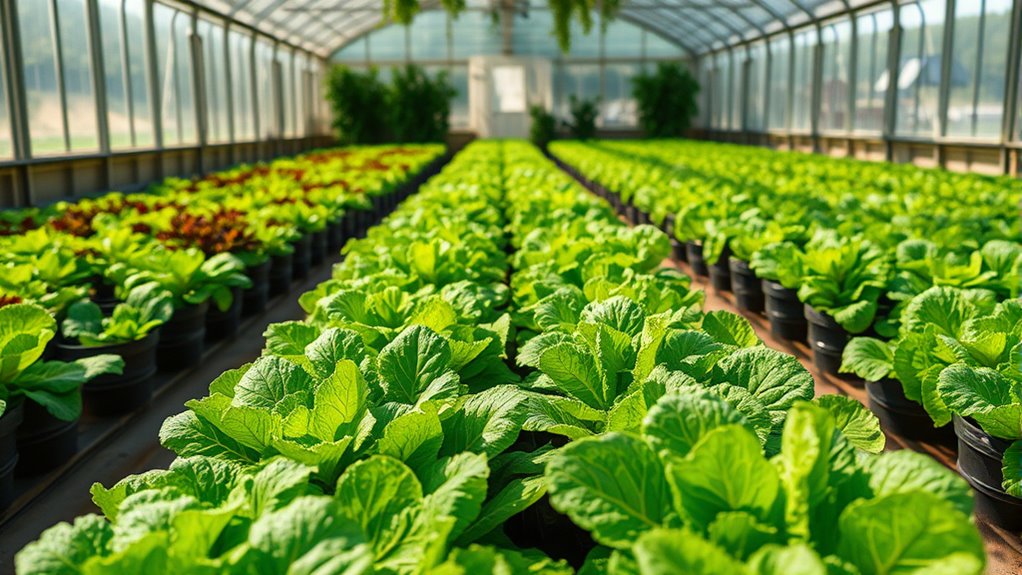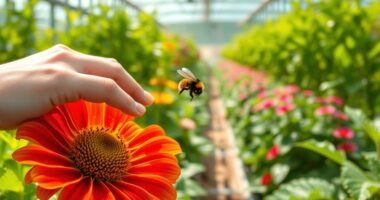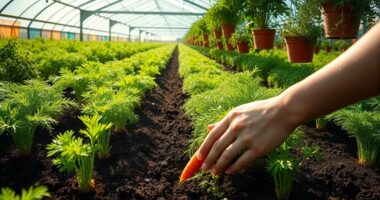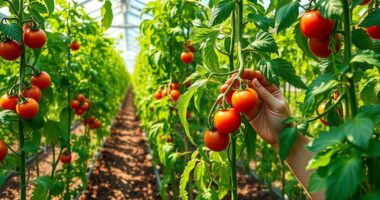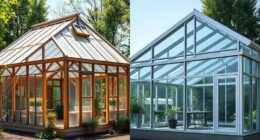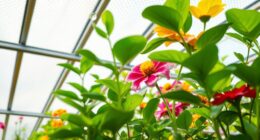To grow lettuce year-round in your greenhouse, keep daytime temperatures between 13°C and 18°C and nighttime temperatures between 12°C and 15°C. Guarantee at least 6 hours of sunlight daily and use LED grow lights for extended exposure. Plant seeds about ⅛" to ¼" deep, spacing them appropriately. Choose cold-hardy or disease-resistant varieties for better yields. Monitor humidity and pests like aphids. There's more to explore about hydroponic systems and best practices that can boost your success!
Key Takeaways
- Maintain greenhouse temperatures between 13°C to 18°C during the day and 12°C to 15°C at night for optimal lettuce growth.
- Ensure at least 6 hours of direct sunlight daily, supplemented with LED grow lights for 12-16 hours if needed.
- Use cold-hardy lettuce varieties like 'Rouge d'Hiver' and 'Arctic King' for winter growing, and fast-growing types like Butterhead for summer.
- Prepare well-drained soil with a pH of 6.0 to 7.0, and keep moisture consistent at about an inch of water weekly.
- Monitor for pests and diseases, applying neem oil as necessary, and harvest in the morning for better crispness.
Optimal Greenhouse Conditions for Lettuce Growth
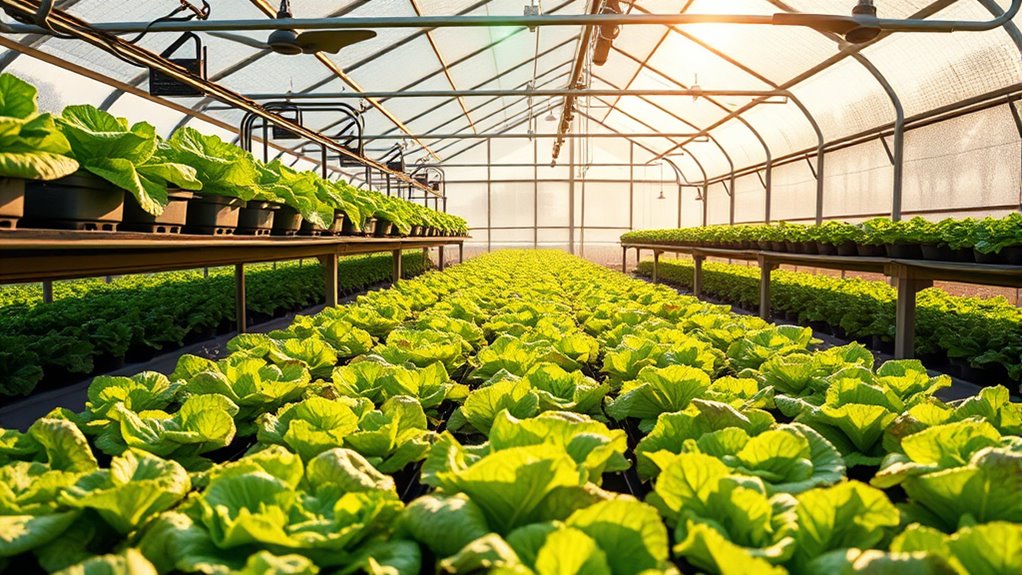
When you're aiming to grow lettuce year-round, establishing ideal greenhouse conditions is vital for success.
Start by maintaining temperatures between 13°C and 18°C during the day, while keeping nighttime temperatures between 12°C and 15°C. This helps prevent stress and promotes healthy growth.
Maintain daytime temperatures of 13°C to 18°C, and nighttime temperatures of 12°C to 15°C for optimal lettuce growth.
Make sure your lettuce gets at least 6 hours of direct sunlight daily, and consider using LED grow lights to extend light exposure to 12-16 hours, especially in winter.
Maintain humidity levels between 50% and 70%, using effective ventilation systems to regulate airflow.
Finally, keep the soil slightly acidic with a pH of around 6.0, and make sure it's well-draining to prevent root rot.
Follow these guidelines, and you'll set the stage for thriving lettuce.
Effective Planting Techniques
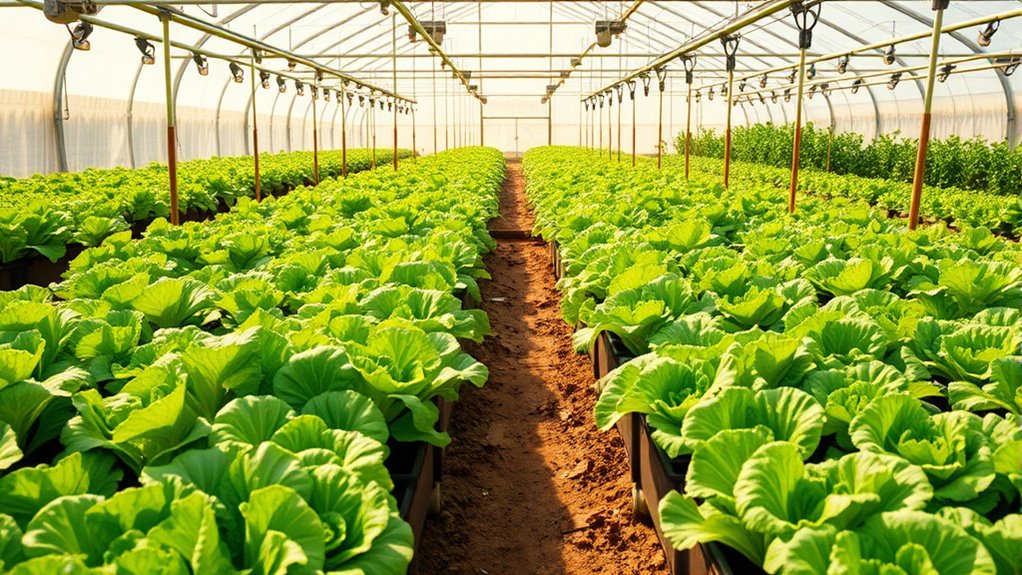
To guarantee successful lettuce growth, you need to implement effective planting techniques that cater to its specific requirements. Start by planting seeds shallowly, about ⅛" to ¼" deep.
Ascertain proper spacing; loose leaf varieties should be 4-8 inches apart, while firm-headed ones need 16 inches. Prepare rich, well-drained soil with a pH between 6.0 and 7.0, adding organic matter and balanced fertilizers.
Consistent moisture is essential, so aim for about an inch of water weekly—consider using an automatic drip irrigation system. Monitor for pests like aphids and slugs, applying neem oil for organic control.
Finally, consider companion planting with crops like mint and beans to boost growth while keeping them away from cabbage and kale.
Selecting the Right Lettuce Varieties

Choosing the right lettuce varieties is essential for achieving year-round growth and maximizing your harvest. Start by selecting cold-hardy options like 'Rouge d'Hiver' and 'Arctic King' for winter, while fast-growing varieties such as Butterhead and Romaine are perfect for quick summer yields.
Consider disease resistance too; 'Chicarita' stands out for its resilience against downy mildew and aphids, ensuring healthier crops. For spring and fall, Bibb lettuce excels with its frost tolerance.
Don't forget specialty varieties like 'Miz America' for vibrant colors and unique flavors. By choosing diverse, adaptable varieties, you'll balance market demand and production efficiency, allowing you to enjoy a continuous supply of fresh lettuce throughout the year.
Hydroponic Systems for Efficient Production
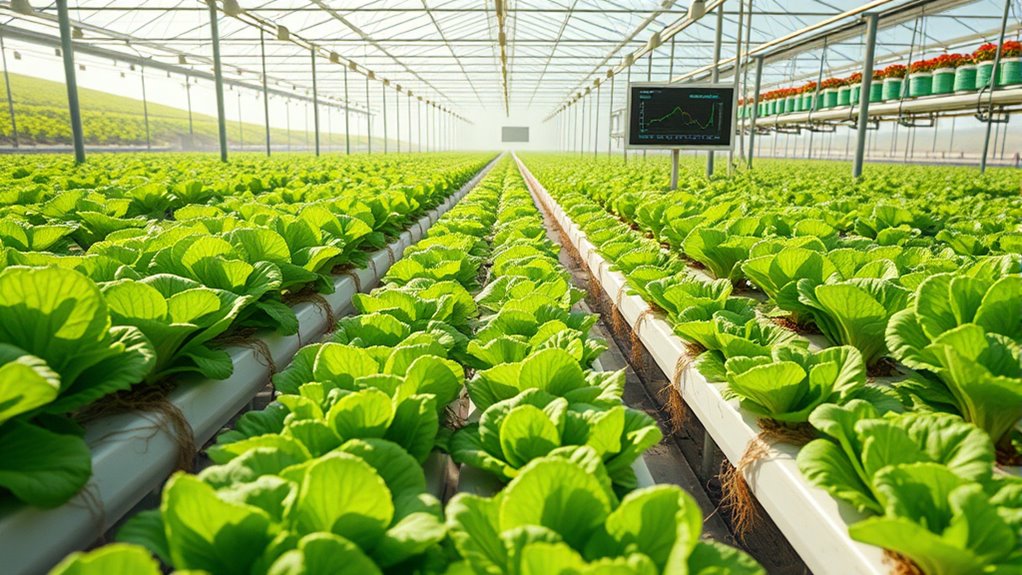
Hydroponic systems provide a revolutionary way to grow lettuce efficiently, allowing you to cultivate fresh greens year-round regardless of outdoor conditions.
You can choose from various systems like Nutrient Film Technique (NFT) or Deep Water Culture (DWC), depending on your space and budget. These systems offer faster growth and precise nutrient control, ensuring your lettuce thrives.
Popular growing mediums, such as rockwool cubes and coconut coir, support healthy root development. With hydroponics, you'll use considerably less water and maximize space through vertical integration.
To get started, gather essential equipment like reservoirs, pumps, and grow lights, and monitor environmental conditions to create the ideal growing environment. This approach guarantees consistent quality and delicious lettuce harvests throughout the year.
Managing Pests and Diseases

Managing pests and diseases is essential for guaranteeing healthy lettuce growth year-round. Common pests like aphids, earwigs, and slugs can threaten your crop, but you can control them effectively. Introduce beneficial insects, such as ladybugs, and use physical barriers like insect screens and sticky traps.
Practice crop rotation and maintain sanitation to reduce pest populations. When necessary, apply organic pesticides for severe infestations.
For disease prevention, choose disease-resistant lettuce varieties and maintain humidity between 50% and 70%. Guarantee proper ventilation and remove crop residues to minimize risks.
Regularly monitor your crops for early pest detection, and keep detailed records to refine your strategies. By employing these integrated pest management techniques, you'll foster a healthier growing environment for your lettuce.
Harvesting and Post-Harvest Best Practices

To guarantee the best quality and flavor of your lettuce, proper harvesting and post-harvest practices are essential.
Harvest in the early morning when it's cooler to reduce wilting. Use sharp, clean pruning scissors or garden shears to avoid damaging the leaves. For leaf lettuce, pick outer leaves first to allow inner ones to mature.
Consider the cut-and-come-again method for continuous harvests or cut the entire head of varieties like romaine. After harvesting, chill the lettuce quickly to maintain crispness and store it in a cool, dry place.
Always sanitize tools and surfaces to prevent disease. Handle the leaves gently, and consume them quickly or refrigerate for up to 10 days for the best flavor.
Frequently Asked Questions
How Can I Extend the Lettuce Growing Season in My Greenhouse?
To extend your lettuce growing season in the greenhouse, maintain temperatures between 10°C and 20°C, and guarantee proper ventilation for air circulation.
Use cold-hardy varieties suitable for cooler weather, and consider succession planting to harvest continuously.
Protect your crops from extreme weather and pests by monitoring regularly and utilizing companion plants.
With these strategies, you'll enjoy fresh lettuce well into the colder months!
What Tools Are Essential for Greenhouse Lettuce Cultivation?
Imagine a gardener, Sarah, who successfully grows fresh lettuce year-round.
To replicate her success, you'll need essential tools like a reliable irrigation system to guarantee proper moisture levels, a ventilation system to maintain airflow, and temperature sensors to monitor ideal conditions.
Additionally, investing in quality harvesting tools like lettuce field knives and shade cloth will protect your crops from harsh weather, guaranteeing a continuous supply of crisp, healthy lettuce.
How Do I Manage Lettuce Growth in Extreme Temperatures?
To manage lettuce growth in extreme temperatures, you need to maintain a stable environment.
Use heating systems to keep temperatures warm during cold spells and insulate your greenhouse with plastic sheets.
During hot weather, guarantee proper ventilation and shading to prevent overheating.
Monitor night temperatures, aiming for 45-55°F, and select cold-resistant varieties that can tolerate temperature fluctuations.
With these strategies, you can support healthy lettuce growth year-round.
Can I Grow Lettuce Alongside Other Crops in My Greenhouse?
Can you really maximize space by growing lettuce alongside other crops? Absolutely!
Lettuce pairs well with crops like onions and carrots, as they share similar growing conditions. This companion planting not only optimizes your greenhouse but also helps deter pests.
Just be mindful of each crop's needs, ensuring they don't compete for resources.
With careful planning, you can enjoy a thriving, diverse greenhouse that keeps your harvest fresh and plentiful throughout the seasons!
What Are the Signs of Nutrient Deficiencies in Lettuce Plants?
You'll notice several signs if your lettuce plants are experiencing nutrient deficiencies.
For nitrogen, look for yellowing lower leaves.
Phosphorus deficiency shows as stunted growth and dark green or purplish leaves.
Potassium issues reveal themselves through yellowing and browning leaf edges.
Magnesium deficiencies cause interveinal yellowing and leaf curling, while calcium deficiency leads to tipburn and distorted growth.
Regular monitoring can help you catch these issues early and guarantee healthy plants.
Conclusion
Growing lettuce year-round in a greenhouse not only guarantees a fresh supply, but it can also boost your yields considerably. Did you know that with the right conditions, you can produce up to 10 times more lettuce in a year compared to traditional outdoor farming? By implementing effective planting techniques and managing pests, you'll be well on your way to enjoying crisp, homegrown lettuce no matter the season. So, dig in and watch your harvest thrive!
